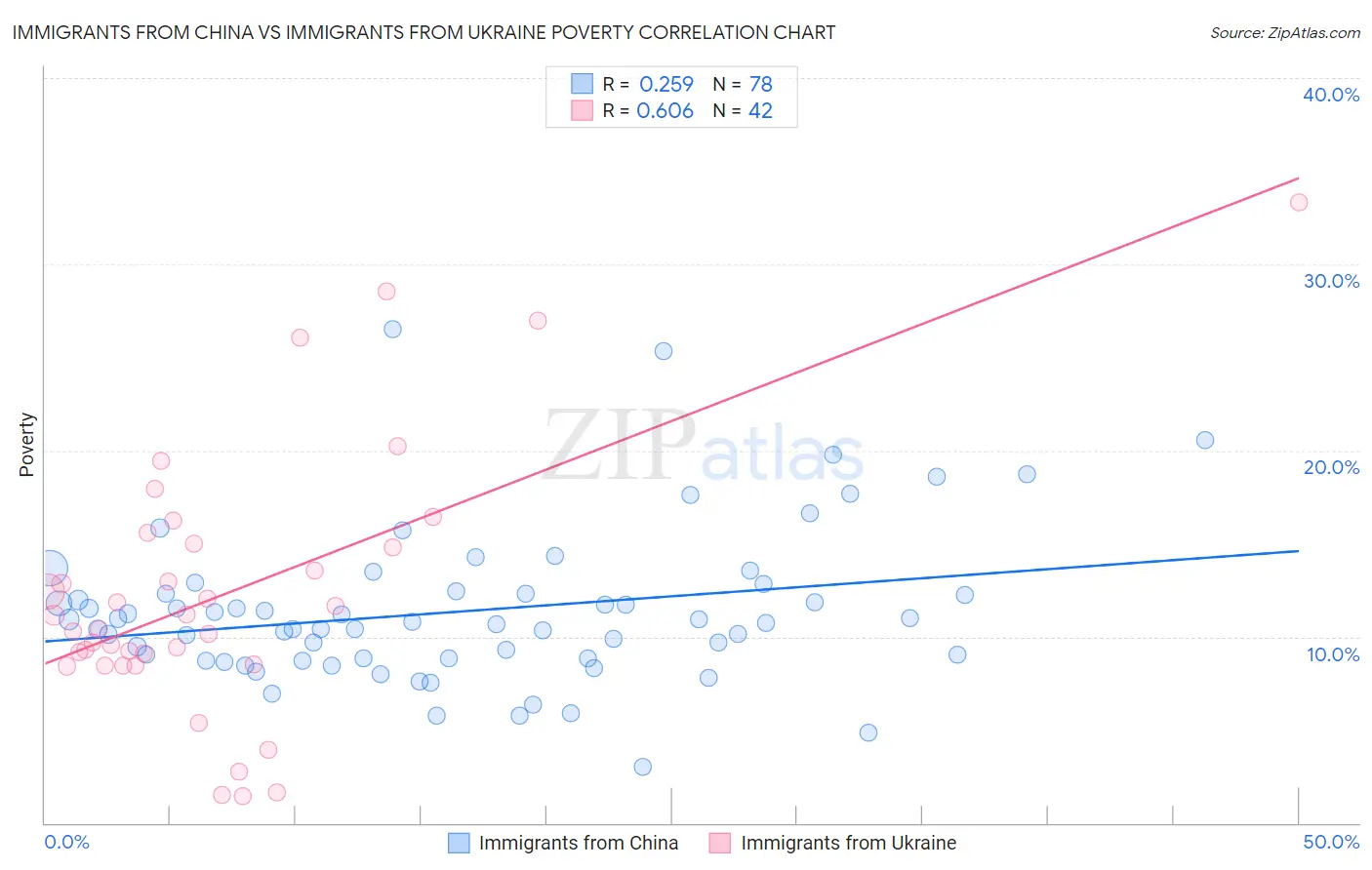Immigrants from China vs Immigrants from Ukraine Poverty
COMPARE
Immigrants from China
Immigrants from Ukraine
Poverty
Poverty Comparison
Immigrants from China
Immigrants from Ukraine
11.6%
POVERTY
90.7/ 100
METRIC RATING
114th/ 347
METRIC RANK
11.8%
POVERTY
86.6/ 100
METRIC RATING
130th/ 347
METRIC RANK
Immigrants from China vs Immigrants from Ukraine Poverty Correlation Chart
The statistical analysis conducted on geographies consisting of 456,587,979 people shows a weak positive correlation between the proportion of Immigrants from China and poverty level in the United States with a correlation coefficient (R) of 0.259 and weighted average of 11.6%. Similarly, the statistical analysis conducted on geographies consisting of 289,636,773 people shows a significant positive correlation between the proportion of Immigrants from Ukraine and poverty level in the United States with a correlation coefficient (R) of 0.606 and weighted average of 11.8%, a difference of 1.1%.

Poverty Correlation Summary
| Measurement | Immigrants from China | Immigrants from Ukraine |
| Minimum | 3.0% | 1.5% |
| Maximum | 26.5% | 33.3% |
| Range | 23.5% | 31.9% |
| Mean | 11.4% | 12.3% |
| Median | 10.8% | 10.8% |
| Interquartile 25% (IQ1) | 8.8% | 8.5% |
| Interquartile 75% (IQ3) | 12.3% | 15.0% |
| Interquartile Range (IQR) | 3.5% | 6.5% |
| Standard Deviation (Sample) | 4.1% | 7.0% |
| Standard Deviation (Population) | 4.1% | 6.9% |
Demographics Similar to Immigrants from China and Immigrants from Ukraine by Poverty
In terms of poverty, the demographic groups most similar to Immigrants from China are Immigrants from Southern Europe (11.6%, a difference of 0.020%), Immigrants from Belarus (11.6%, a difference of 0.020%), Albanian (11.7%, a difference of 0.14%), Immigrants from Russia (11.7%, a difference of 0.31%), and Sri Lankan (11.7%, a difference of 0.38%). Similarly, the demographic groups most similar to Immigrants from Ukraine are South African (11.7%, a difference of 0.090%), French (11.8%, a difference of 0.10%), Immigrants from Israel (11.7%, a difference of 0.19%), Peruvian (11.8%, a difference of 0.21%), and Immigrants from Argentina (11.7%, a difference of 0.31%).
| Demographics | Rating | Rank | Poverty |
| Immigrants | Southern Europe | 90.8 /100 | #112 | Exceptional 11.6% |
| Immigrants | Belarus | 90.8 /100 | #113 | Exceptional 11.6% |
| Immigrants | China | 90.7 /100 | #114 | Exceptional 11.6% |
| Albanians | 90.3 /100 | #115 | Exceptional 11.7% |
| Immigrants | Russia | 89.7 /100 | #116 | Excellent 11.7% |
| Sri Lankans | 89.4 /100 | #117 | Excellent 11.7% |
| Argentineans | 89.1 /100 | #118 | Excellent 11.7% |
| Tlingit-Haida | 89.0 /100 | #119 | Excellent 11.7% |
| Immigrants | South Eastern Asia | 88.9 /100 | #120 | Excellent 11.7% |
| New Zealanders | 88.7 /100 | #121 | Excellent 11.7% |
| Puget Sound Salish | 88.7 /100 | #122 | Excellent 11.7% |
| Immigrants | Hungary | 88.6 /100 | #123 | Excellent 11.7% |
| Soviet Union | 88.4 /100 | #124 | Excellent 11.7% |
| Immigrants | Brazil | 88.2 /100 | #125 | Excellent 11.7% |
| Immigrants | Norway | 88.0 /100 | #126 | Excellent 11.7% |
| Immigrants | Argentina | 88.0 /100 | #127 | Excellent 11.7% |
| Immigrants | Israel | 87.4 /100 | #128 | Excellent 11.7% |
| South Africans | 87.0 /100 | #129 | Excellent 11.7% |
| Immigrants | Ukraine | 86.6 /100 | #130 | Excellent 11.8% |
| French | 86.1 /100 | #131 | Excellent 11.8% |
| Peruvians | 85.6 /100 | #132 | Excellent 11.8% |